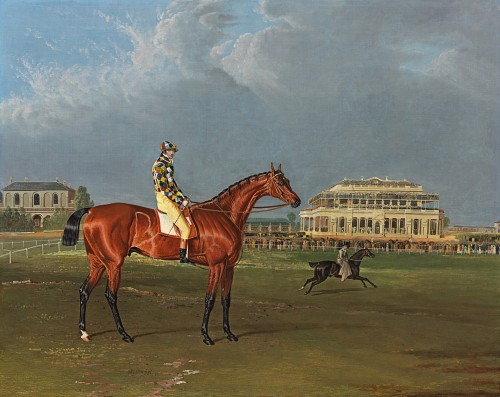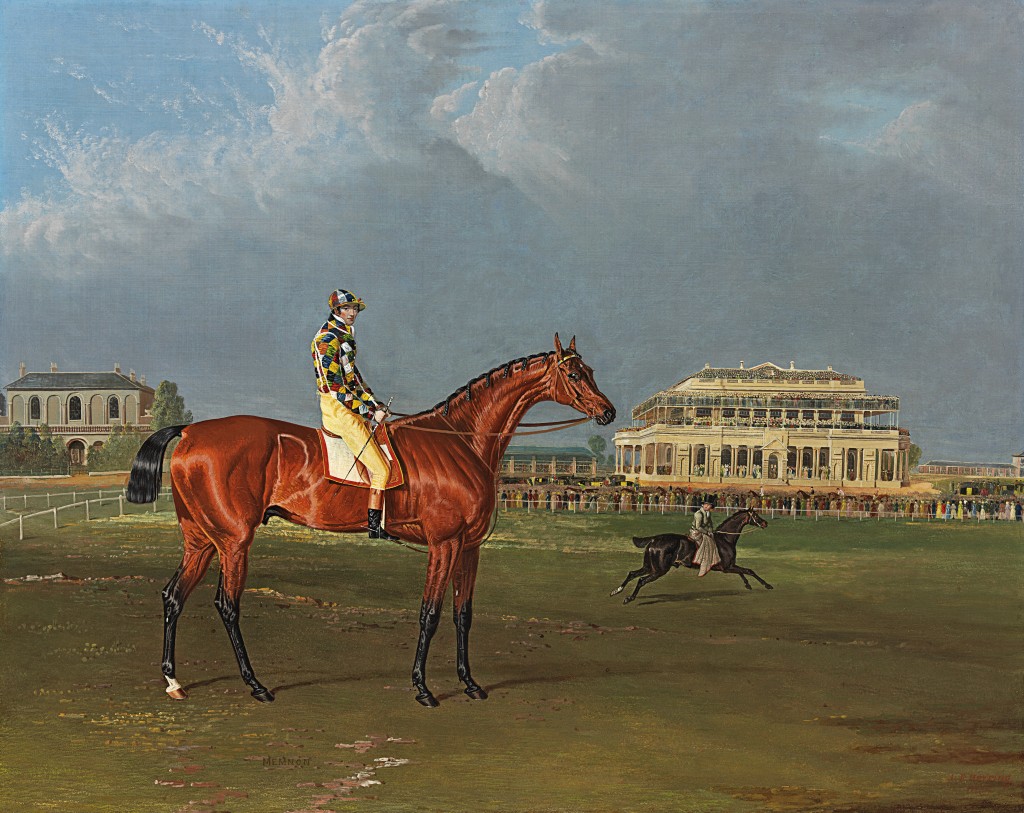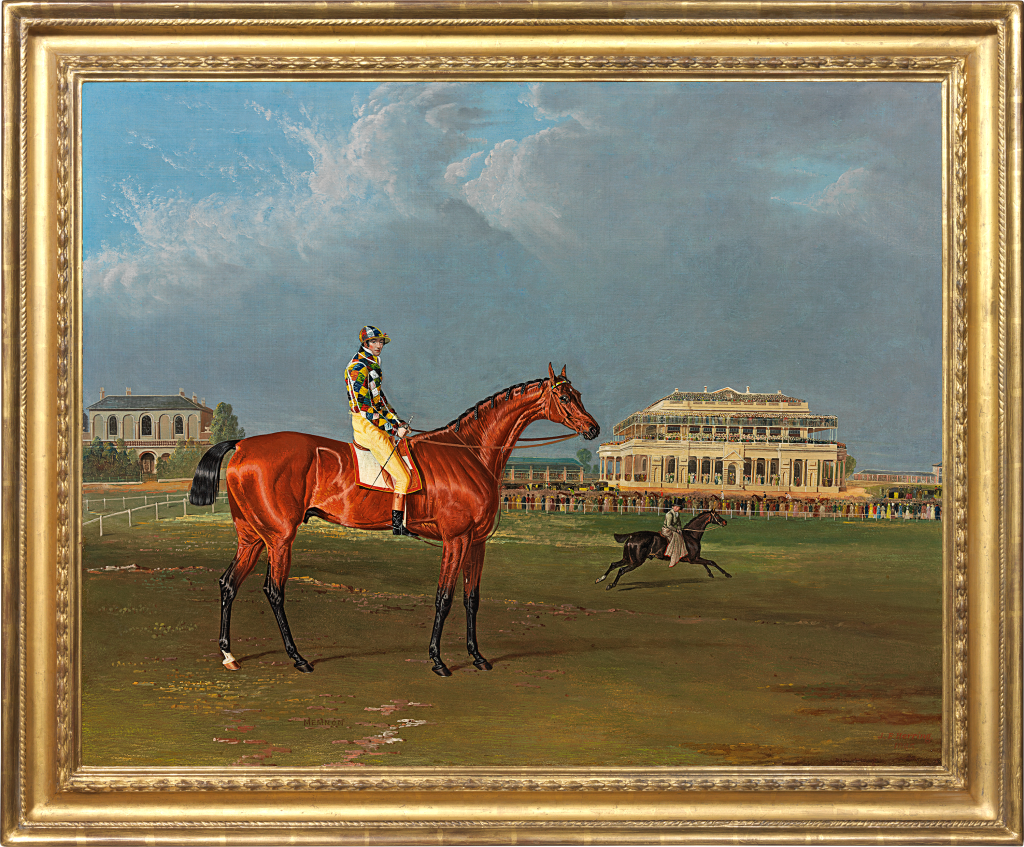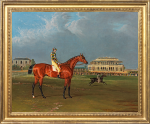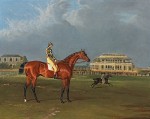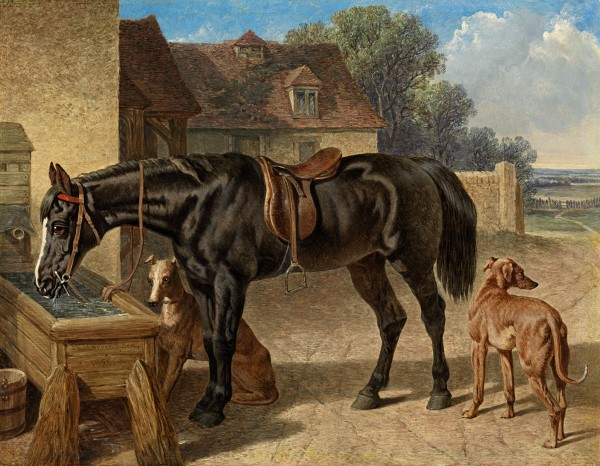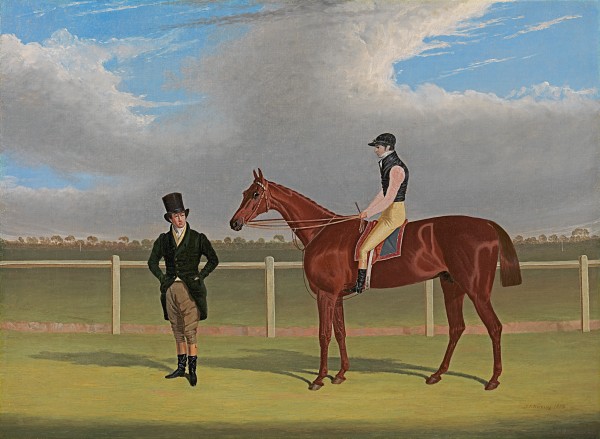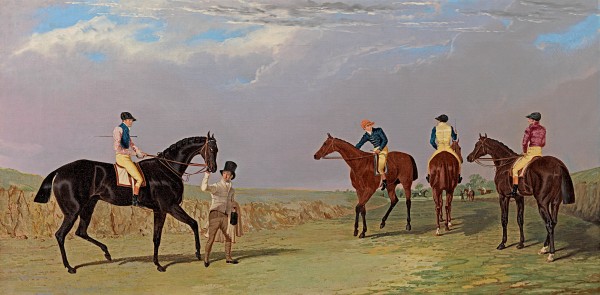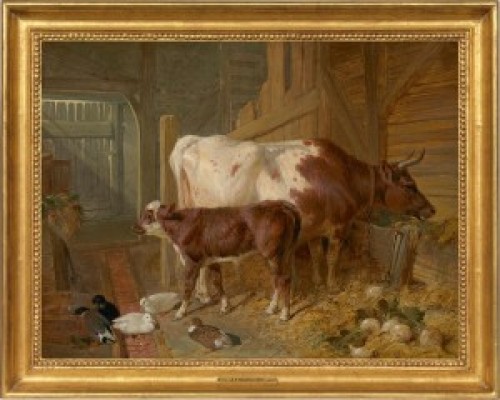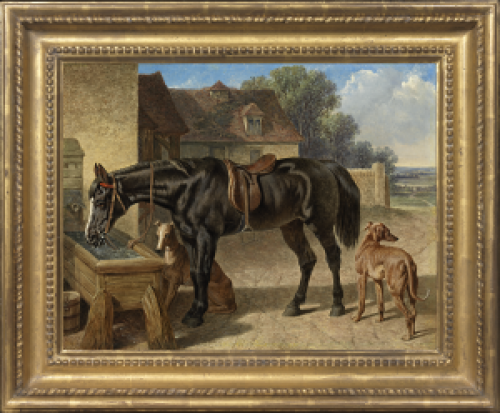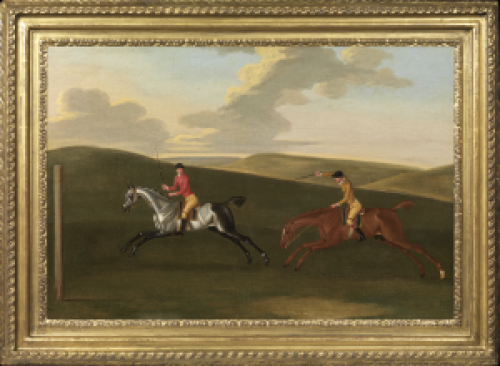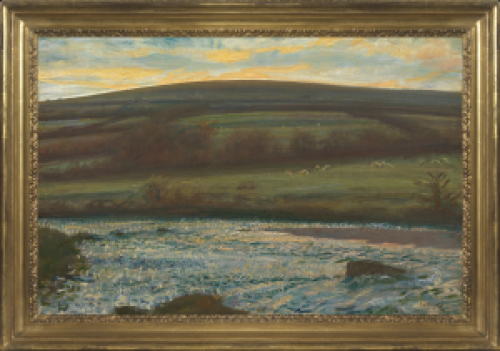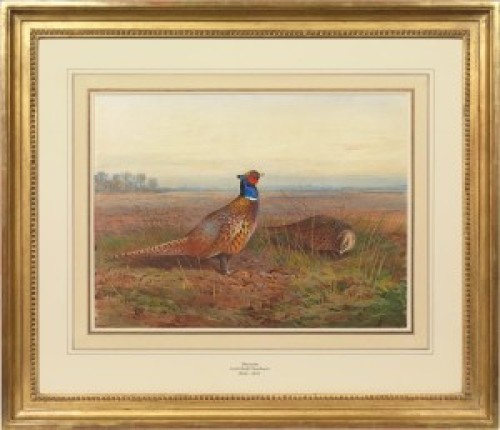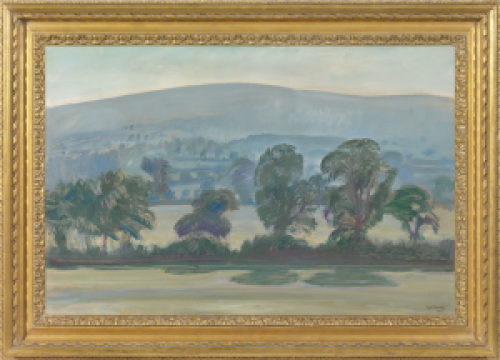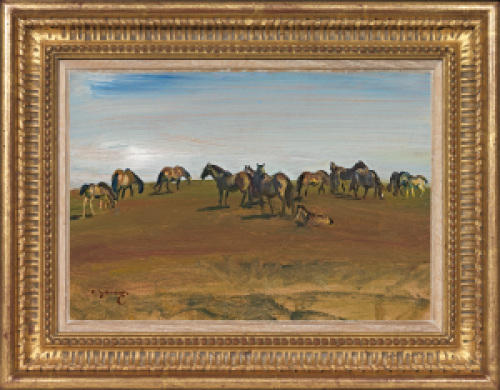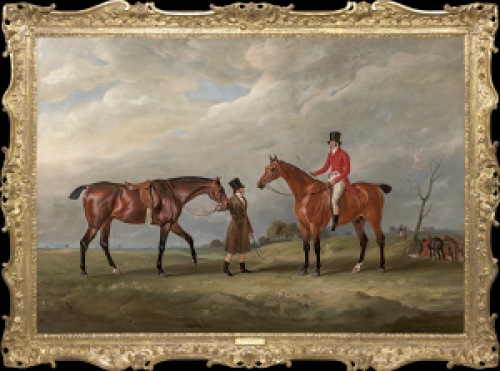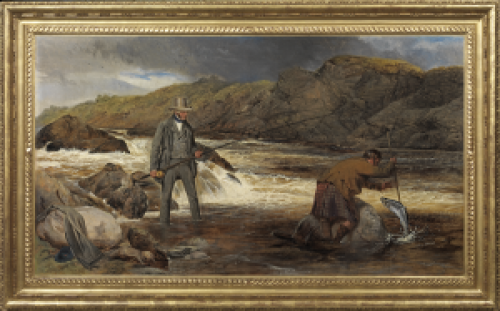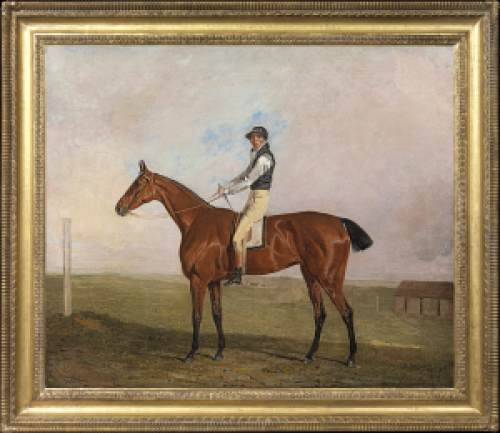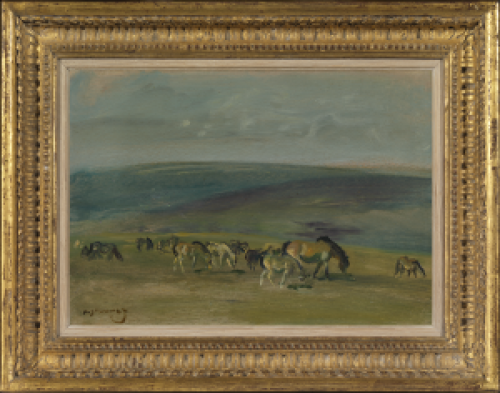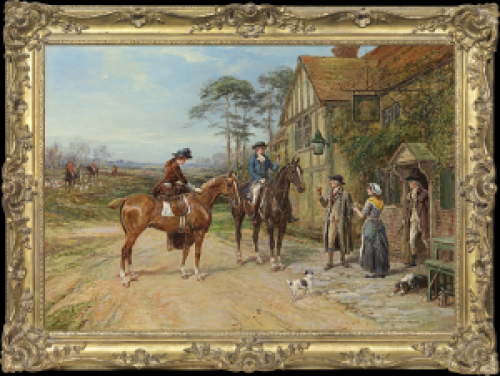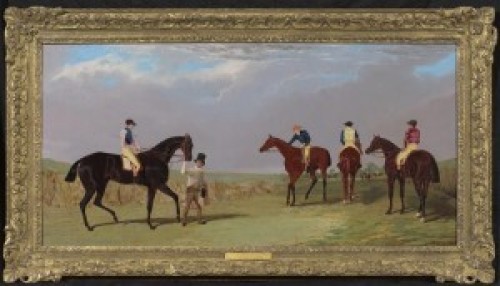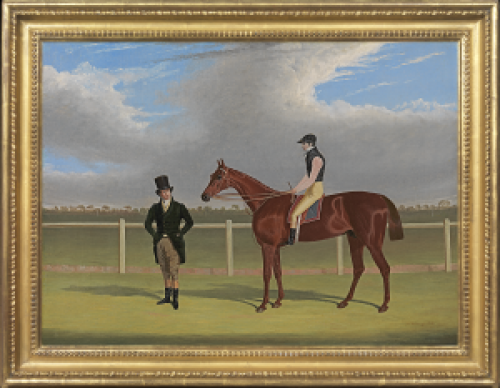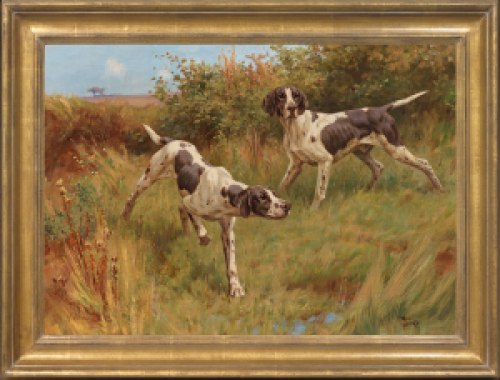JOHN FREDERICK HERRING SNR
Surrey 1795 - 1865 Meopham Park, Kent
Ref: CD 103
Mr Richard Watt’s Memnon with William Scott up at Doncaster
Signed, inscribed and dated lower right: J. Herring F. 1825; inscribed lower left: Memnon
Oil on canvas: 27 ¼ x 34 in / 69.2 x 86.4 cm
Frame size:
In an English eighteenth century style hollow frame
Engraved:
In aquatint by T Sutherland and published in 1826 by Sheardown & Son of Doncaster for their series The Winning Horses of the Great St Leger at Doncaster
Provenance:
Richard Watt III (1786-1855) of Bishop Burton, Yorkshire;
his daughter Mrs Harrington Hudson;
by descent to Major JH Hudson, MC;
by whom sold, Christie’s London, 16th April 1982, lot 42;
Richard Green, London;
private collection, USA, 1982;
Richard Green, London, 1994;
private collection, Pennsylvania, USA
Literature:
John Fairley, Great Racehorses in Art, Oxford 1984, p.100, illus.
The Doncaster St Leger is the oldest of English racing’s Classics (the others being the 2,000 Guineas, the 1,000 Guineas, Oaks and Derby). First run as a Sweepstake of twenty-five guineas over two miles in 1776, it was the brainchild of an Irish officer in the British Army, Colonel Anthony St Leger (1731-1786), who had an estate at Firbeck in South Yorkshire. The race for three-year-old colts and fillies was officially christened the St Leger in 1778 and is held in September, the last of the Classics in the calendar.
John Frederick Herring Snr lived in Doncaster from 1814 to 1830; the St Leger is synonymous with the success of the first half of his career. Well-liked by the Yorkshire racing fraternity, he was granted exclusive rights to paint the winner of the St Leger before any other artist, portraying them between 1815 and 1849, missing only three years, 1841, 1842 and 1848. He was celebrated for the speed and skill with which he depicted the victors, catching acute likenesses of both horses and jockeys. Commissions were all but assured from the owner (or subsequent owners) of the horse, while Herring’s and the animal’s fame were further disseminated by prints after the paintings.
This magnificent work depicts the bay colt Memnon, bred and owned by Mr Richard Watt of Bishop Burton, Yorkshire, with William Scott up in Watt’s harlequin colours. Behind is the dazzling new grandstand inaugurated in 1825 for the Doncaster Racing Club. The sixty shareholders and subscribers included four Dukes and four Marquesses.
Foaled in 1822, by Whisker out of Manuella, Memnon won the York St Leger in 1825. He started favourite for the Doncaster St Leger at 3 to 1, out of a large field of thirty. His jockey, ‘Bill’ Scott, hard-riding, hard-living and ‘Yorkshire’s darling’[1], would notch up nine St Leger wins, four Derbys and three Oaks. Before the race, Watt was offered 4,000 guineas for Memnon, by someone who had laid heavily against him. Watt refused, saying that ‘Until the St Leger has been run, Memnon belongs to the public and money would not buy him’. Memnon won the race by three lengths from an old rival, Lord Queensberry’s The Alderman. Thanks to popular fervour, the result was flown to London by carrier pigeons and reached Manchester by specially trained dogs. Betting had been heavy: two of the notable blackguards and blacklegs of the Turf, ex-stable boy Robert Ridsdale and ex-prizefighter John Gully, won vast sums on Memnon. The horse was promptly sold by Watt to Lord Darlington (the future Duke of Cleveland) for 3,500 guineas.
In 1827 Memnon won a match at Newmarket for 1,000 sovereigns with Sam Chifney Jnr up, beating Lord Exeter’s Enamel. Chifney repeated the feat in the Gold Cup at Ascot, beating George IV’s Mortgage. The following year Memnon was retired to Lord Cleveland’s stud at Raby Castle. In 1833 he was exported to Russia.
Herring made another version of this painting which was owned by Bill Scott’s trainer brother John and later in the Paul Mellon Collection[2]. A third portrait of Memnon with a landscape background was made for Lord Darlington[3].
JOHN FREDERICK HERRING, Senior
Surrey 1795 - 1865 Meopham Park, Kent
John Frederick Herring was the son of a London merchant of Dutch parentage, who had been born in America. The first eighteen years of his life were spent in London, where his greatest interests were drawing and horses. In 1814 he moved to Doncaster, arriving just in time to see the Duke of Hamilton’s William win the St Leger. By 1815 he had married Ann Harris; his sons John Frederick Herring Junior, Charles and Benjamin were all to become artists, while his daughters Ann and Emma both married painters.
In Doncaster, Herring earned his living as a painter of coach insignia and inn signs and his contact with a firm owned by a Mr Wood led to his subsequent employment as a night coach driver. His spare time was spent painting portraits of horses for inn parlours and he became known as the ‘artist coachman’. Herring’s talent was quickly recognised and he soon found himself painting hunters and racehorses for the gentry.
In 1830, Herring left Doncaster for Newmarket, where he spent three years before moving to London. During this time, he may have received tuition from Abraham Cooper. In London, Herring got into financial difficulties and was rescued by W T Copeland, who commissioned many paintings including designs used for Copeland Spode bone china. In 1840-41, Herring visited Paris by invitation of the Duc d’Orleans, for whom he painted several pictures. In 1845, Herring was appointed Animal Painter to HRH the Duchess of Kent, followed by a commission from Queen Victoria, who was to remain a patron for the rest of his life.
Herring spent the last twelve years of his life at Meopham Park near Tonbridge, where he lived as a country squire. He now broadened his subject matter and painted agricultural scenes and narrative pictures, as well as his better known works of hunting, racing and shooting. A highly successful and prolific artist, Herring ranks with Sir Edwin Landseer as one of the most eminent animal painters of the mid nineteenth century. His paintings were very popular and many were engraved, including his thirty-three winners of the St Leger and his twenty-one winners of the Derby. Herring exhibited at the Royal Academy 1818-65, the British Institution 1830-65 and the Society of British Artists (whose Vice-President he became in 1842), 1836-52.
[1] Christopher McGrath, Mr Darley’s Arabian, London 2017, p.114.
[2] Today in the Yale Center for British Art, New Haven, CT. Signed and dated 1825, with part of the building at the far left omitted. Oil on canvas: 26 ½ x 33 ¼ in / 67.5 x 84.5 cm. Judy Egerton, British Sporting and Animal Paintings 1655-1867: the Paul Mellon Collection, pp.293-4, illus. in colour.
[3] Signed and dated 1826. Oil on canvas: 30 x 40 in / 76.2 x 101.6 cm. Mr and Mrs Jack Dick Collection, Sotheby’s London, 28th April 1976, pp.60-61, lot 159, illus. in colour.

